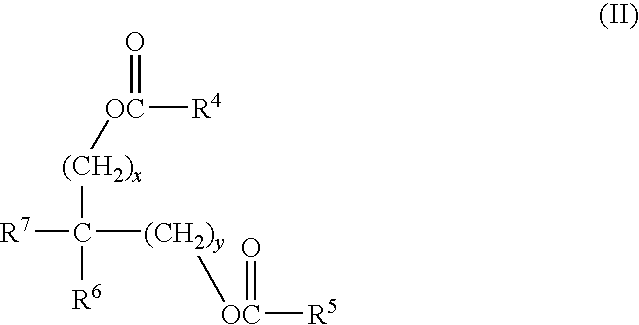Engine oil compostions
a technology of engine oil and compostions, which is applied in the direction of lubricant compositions, base materials, additives, etc., can solve the problems of substantially reducing the life and effectiveness of catalytic converters, affecting the life and activity of catalytic converters, and simple base oils alone do not provide the necessary properties to provide adequate wear protection, etc., to achieve high anti-wear, facilitate longer catalytic converter life and activity, and high deposit protection
- Summary
- Abstract
- Description
- Claims
- Application Information
AI Technical Summary
Benefits of technology
Problems solved by technology
Method used
Image
Examples
examples
[0071]The following examples provide lubricating oil compositions which were formulated to give viscosity conditions of a SAE 5W30 oil defined in the Society of Automotive Engineers classification system SAE J300.
example 1
[0083]A lubricating oil composition was formed by adding to a mixture of 78 wt. % of CHEVRON 100N (a Group II base oil) commercially available from ChevronTexaco Corp. (San Ramon, Calif.), 21.9 wt. % of CHEVRON 220N (a Group II base oil) commercially available from ChevronTexaco Corp. (San Ramon, Calif.) and 0.1 wt. % of Cargill AP560 (transesterified product of canola oil and TMP triheptanoate) available from Cargill, Incorporated (Wayzata, Minn.), the additive package of Comparative Example A. The lubricating oil composition possessed a phosphorous content of 0.08 wt. % and a sulfur content of 0.2 wt. %.
example 2
[0084]A lubricating oil composition was formed by adding to a mixture of 78.2 wt. % of CHEVRON 100N (a Group II base oil) commercially available from ChevronTexaco Corp. (San Ramon, Calif.), 21.4 wt. % of CHEVRON 220N (a Group II base oil) commercially available from ChevronTexaco Corp. (San Ramon, Calif.) and 0.4 wt. % of Cargill AP560 (transesterified product of canola oil and TMP triheptanoate) available from Cargill, Incorporated (Wayzata, Minn.), the additive package of Comparative Example A. The lubricating oil composition possessed a phosphorous content of 0.08 wt. % and a sulfur content of 0.2 wt. %.
PUM
| Property | Measurement | Unit |
|---|---|---|
| kinematic viscosity | aaaaa | aaaaa |
| kinematic viscosity | aaaaa | aaaaa |
| kinematic viscosity | aaaaa | aaaaa |
Abstract
Description
Claims
Application Information
 Login to View More
Login to View More - R&D
- Intellectual Property
- Life Sciences
- Materials
- Tech Scout
- Unparalleled Data Quality
- Higher Quality Content
- 60% Fewer Hallucinations
Browse by: Latest US Patents, China's latest patents, Technical Efficacy Thesaurus, Application Domain, Technology Topic, Popular Technical Reports.
© 2025 PatSnap. All rights reserved.Legal|Privacy policy|Modern Slavery Act Transparency Statement|Sitemap|About US| Contact US: help@patsnap.com



